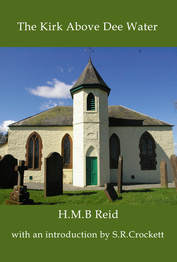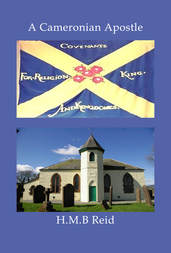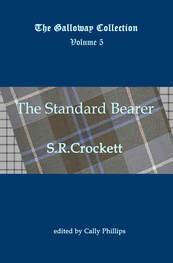|
‘Above Dee Water is a Kirk; and about that again there is a dearer kirkyard. It is a lonesome spot, at least for those who love not to look down upon broad water meadows in which the Lammas floods spread wide, or who cannot be content with the sough of the leaves for company about the old Manse.’  An evocative place, Balmaghie Kirk has a long history. The current building was completed in 1794. It was renovated in 1894. But long before that, it was the kirk of John Macmillan – ordained minister of Balmaghie in 1701. He was a covenanter. He is buried in the kirkyard. The Kirk of Balmaghie is situated on the very edge of the parish, most inconveniently for pastoral work, though to the advantage of the minister's quiet when preparing his sermon. All who would know more of the truth about Balmaghie Kirk must get Professor Reid's very excellent little book, ‘The Kirk above Dee Water.’ It tells of the Kirk, its ministers, of the martyrs also, and the many saintly folk who lie buried in that solitude. The local writer S.R.Crockett wrote the introduction to Reid’s book. He is also buried in the Kirkyard.  The life of Macmillan, its famous minister, has been for the first time worthily written by Dr. Reid. ‘The Cameronian Apostle’ cannot be recommended too often or too highly. It is, in my humble opinion, one of the most successful pieces of sympathetic biography ever written. And having made an attempt of the same kind in fiction, I know of what I do speak. I will return to plunder Dr. Reid's book presently. Meantime I give the words of Macmillan as they were imagined with regard to his parish. ‘Balmaghie was a parish greatly to my mind (so he is represented as writing). It lies, as everyone knows, in the very heart of Galloway, between the slow, placid, sylvan stretches of the Ken and the roaring, turbulent mill-race of the Black Water of Dee. ‘From a worldly point of view the parish is most desirable; for though the income in money and grain is not great, nevertheless the whole amount is equal to the income of most of the smaller lairds in the neighbourhood. So at last I was settled in my parish, which was indeed a good and desirable one as times went. The manse had recently been put in order. It was a pleasant stone house, which sat in the bieldy hollow beneath the Kirk Knowe of Balmaghie. Snug and sheltered it lay, an encampment of great beeches sheltering it from the northerly blasts, and the green-bosomed hills looking down upon it with kindly tolerant silence. Crockett wrote poignantly of Balmaghie. ‘Close by the highway is an unforgotten little elbow of road. The loaning runs straight up and down now, but you can still see the bend of the old path and the green bank—nay, only I know where to look for that—the bank on which my mother sat and sang me ‘The Lord's my Shepherd’ on Sabbath afternoons. For of all those who were a part of these things, only one now remains upon the earth. The rest are over the hill yonder, in the Balmaghie kirkyard, the sweetest and the sunniest God's Acre in Scotland, and since such things must needs be, doubtless a right desirable place for any tired wanderer's resting-grave.’ ‘To some among us Balmaghie Church appeals more nearly still. Dear dust lies in that kirkyard, and as the years pass by, for many of us, more and more of it gathers under the kirk on the hill. The tides of the world, its compulsions, its needs, and its must be's, lead me up the loaning but seldom. Indeed I am not often there, save when the beat of the passing bell calls another to the long quiet rest. But when the years are over, many or few, and our Galloway requiem, ‘Sae he's won awa',’ is said of me—that is the bell I should like rung. And there, in the high corner, I should like to lie, if so the fates allot it, among the dear and simple folk I knew and loved in youth. Let them lay me not far from the martyrs, where one can hear the birds crying in the minister's lilac-bushes, and Dee kissing the river grasses, as he lingers a little wistfully about the bonny green kirk-knowe of Balmaghie.’  Crockett also revisited history in his fictional work ‘The Standard Bearer’ which gives a fictional version of the life of John Macmillan. Balmaghie Kirk was closed in 2015. The Church of Scotland are looking to sell it off, along with the hall. In 1703 the locals under John Macmillan put up a fight for Balmaghie Kirk. S.R.Crockett fictionalised this in ‘The Standard Bearer’ Is history destined to repeat itself? Surely a more fitting tribute to the rich cultural contribution of people and places (including S.R.Crockett) would be keeping these buildings in community ownership. I hope the Church of Scotland sees sense and does the right thing this time around. Crockett is still vastly underappreciated even in his native parish. Perhaps if we were better at paying tribute to our own and appreciating our local culture and heritage a value would be placed on Balmaghie Kirk over and above that of its sale price. I can think of no better place to keep the Crockett archive and ‘stories’ alive than here right next to where he is buried. If you want to find out more about Balmaghie Kirk in fact and fiction you can download 3 free ebooks (in pdf format) as ‘The Balmaghie Bundle’ from the unco store. HERE
0 Comments
Leave a Reply. |
newsyour chance to interact with Galloway Raiders and what's going on. Archives
November 2017
Categories |

 RSS Feed
RSS Feed
